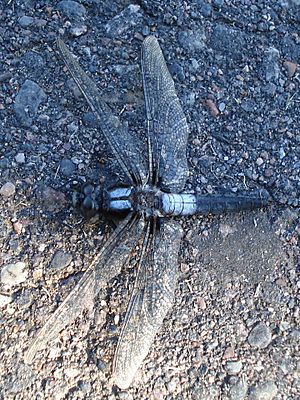Chalk-fronted corporal facts for kids
Quick facts for kids Chalk-fronted corporal |
|
|---|---|
 |
|
| Male | |
| Conservation status | |
| Scientific classification | |
| Kingdom: | |
| Phylum: | |
| Subphylum: | |
| Class: | |
| Order: | |
| Suborder: | |
| Family: |
Libellulidae
|
| Genus: |
Ladona
|
| Species: |
L. julia
|
| Binomial name | |
| Ladona julia Uhler, 1857
|
|
The chalk-fronted corporal (Ladona julia) is a type of dragonfly known as a "skimmer." You can find these cool insects in the northern parts of the United States and southern Canada. They are named for the chalky white patch that appears on their bodies as they grow up.
Contents
What Do They Look Like?
When they are young, both male and female chalk-fronted corporals are a light reddish-brown color. They have white stripes on their "shoulders" (the top part of their body, called the thorax). They also have a black stripe running down the middle of their tail-like body part, which is called the abdomen.
Growing Up: Color Changes
As male chalk-fronted corporals get older, they change quite a bit! A powdery white coating, called pruinescence, appears on the top of their thorax and at the base of their abdomen. The rest of their abdomen turns black. This white patch is why they are called "chalk-fronted."
Female chalk-fronted corporals usually become a dark brown color all over. They might have a light dusting of gray powder near the base of their abdomen. Sometimes, a few females will even develop the same white and black colors as the males.
Where Do They Hang Out?
Chalk-fronted corporals love to sit still! They often perch flat on the ground. You might also see them resting on things floating in the water. From their perch, they quickly fly up to catch their prey right out of the air.
Friendly Dragonflies
These dragonflies are quite social, which is unusual for dragonflies! You will often see them perching together in groups. They are not shy around people either. In fact, they often come close to humans. Why? Because humans attract tasty snacks for them, like mosquitoes and biting flies! So, they are actually quite helpful to have around.
Gallery







